Master ZuZhou's Ancient Tales - newly illustrated
These tales were recorded by a European traveler before the times of Erasmus and show the intercultural experience of this interested novice to Chinese cultures. The texts were edited carefully and made available here for the first time
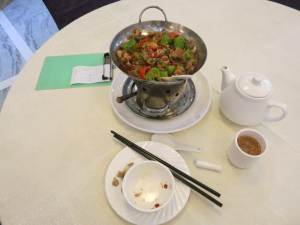 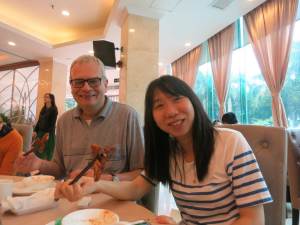 |
A special meal - 1 up? I was not very hungry and I didn’t want to walk far, so I went to the distinguished hotel restaurant next to the guest house. I looked at the menu and noticed that I had to use the opportunity to get something special in this guaranteed safe hygienic environment. So I thought let’s have a little “protected adventure” and I ordered “Sautéed bull frog in spicy sauce”, as it said under the colourful picture. ZuZhou, 04.09 |
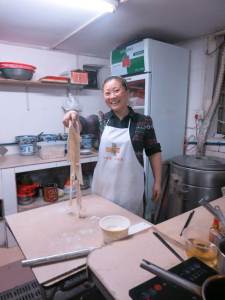 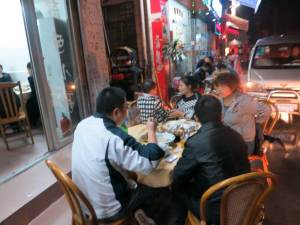 |
A special meal - 1 down? My (former) Sun Yat-sen University students wanted to take me out for dinner. We passed the students’ dormitories on the Eastern side of Campus, until we reached a small hole in the North-Eastern corner of the vast Sun Yat-sen University Campus that took us out through a tiny hole into a very busy food lane. The students knew exactly what they wanted, since one of them came from Hunan and promised the best simple kitchen of all. We passed several other, more or less inviting, places until at the far end of the lane we reached a small restaurant, in which an obviously happy family was busy producing noodles separately for every single eater who came along. They were extremely happy and pleased to see the students bringing a European and they all discussed what would be good for me: A hot chicken soup with hand-made noodles freshly made could not be wrong. The students were not very hungry, two were at least tempted to have the same. One of the students also took the opportunity to take pictures of our dishes being prepared. I must admit that the thick noodles were not easy to eat with chopsticks but they were nicely spiced - not too hot, just right for a surprisingly cold April evening in Guangzhou. The next morning, I told the Professor of German that I had discovered part of the real life of China again and she was very surprised because she had never been there, it seemed a different world. “But maybe only my daughter goes there”. ZuZhou, 04.10 |
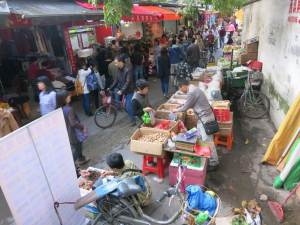 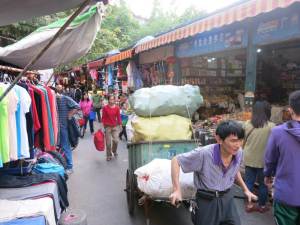 |
The real China behind the wall On Sunday afternoon, I took a leisurely stroll around the South Campus, watching the football players and the card players near the staff housing on the Western side of Campus. Suddenly I discovered a small gate in the wall that was used by many people who were packed with vegetables and small items, their daily shopping. I looked through and discovered a bustling market street Chinese style. In front of the Bautze shop, there was a huge crowd almost fighting for the precious hot delicacies as they came fresh out of the steam. I wandered along and the street got narrower and narrower. I felt like in a village scene of a crammed Hutong. People were walking around in their slippers, the elderly sipping their teas on a tiny stool, children still chasing the football though there was absolutely no space anywhere to play properly. All the tiny shops were wide open: the hairdresser and the baker, the vegetables and the flowers, everything you need for a beautiful and comfortable life behind university walls in the traditional Chinese atmosphere. ZuZhou, 04.13 |
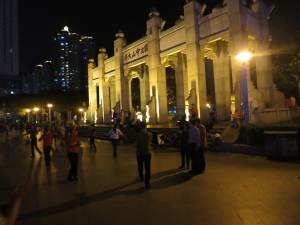 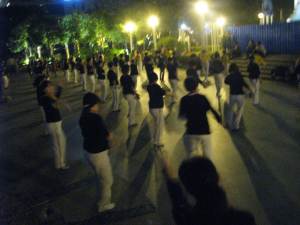 |
Conflicting Space? „Hello, what do you think of all this here?” I was generally surprised to be addressed by a group of four young ladies who spoke English very well and did not want to take a picture with the ‘long noses’. ZuZhou, 04.15 |
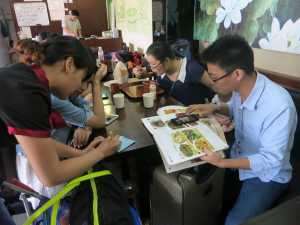 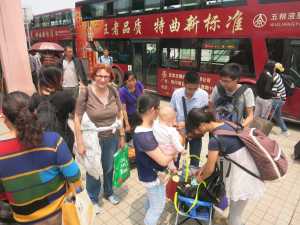 |
"Go together, eat first" - Chinese tradition We just managed to catch the bus and were given two convenient seats for the trip to GuiLin next to two families with a young baby. We chatted in broken English with them and the baby and when we left the bus at GuiLin coach station, they said that they also wanted to catch the new high speed train to Guangzhou only half an hour after us. So they suggested: “Go together” and when we agreed, they suggested: “Eat first” and so we followed them into a neat local restaurant just opposite the coach station. They helped us to order two modest dishes from the Chinese only menu and we were very pleased with it. Before we finished our plates, they even typed into their smartphones: “Eat slowly, we have time”. When we had finished and wanted to invite them, they pointed out clearly that they had paid already: “Chinese custom“. So we went out and noticed that we had been adopted by an extended Chinese family with whom trooped across the coach station again to the trunk road opposite and only sixty metres down we stopped at a bus stop where every member of the extended family was handed the one Yuan note that was necessary for the local travel. Thank God we had enough time to enjoy a one hour bus tour through different, in particular modern parts of the city, which turned out to be much bigger and glibalised than we had expected. Finally we arrived at the not-so-brand-new high speed train station and took a quick but extremely friendly farewell from our extended Chinese family. ZuZhou, 04.28 |
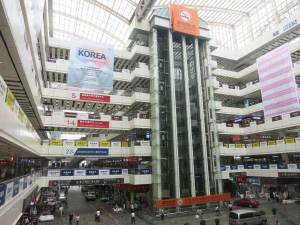 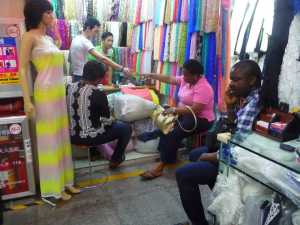 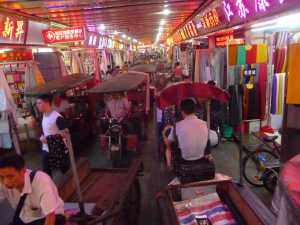 |
Guangdong Textile City: The maze of fabrics and accessories centres Just outside of the Sun Yat-sen University’s main gate, there is a maze. The numbers on the shops are from A to E and from 1 for the ground floor to 6 for the fifth floor with all the service institutions. On the ground floor the traffic is like hell, in particular in the afternoon when the cloths that were ordered in the morning are delivered by the whole-sellers and the byers can collect them if they manage to find them again and survive the traffic because in these buildings there are numerous vehicles from hand-drawn carriages to electric bikes and small cars that are necessary depending on the size of the delivery. It is always best to take a card from the shop where you buy. Usually they only sell whole-sale but they also make exceptions, in particular for long-nosed customers. If you want to find them for sure you better take a picture of the shop including the shop number like E1118 where we find an amazing array of samples in various colours and spices in really amazing quantities. However, that is only the first part of the maze. The second part consists of finding the tailor that can produce a European style blouse or skirt out of the fabrics. Theoretically the choice is easy because just outside of the Textile City there are small kiosks who sell catalogues of the coming fashions, in particular Korean (pop) style for the next 15 years. The catalogue for Korean style for 2030 has just come out. ZuZhou, 05.08 |
|
Following Avatar and the masses We were early at the park entrance and the more than 20 gates looked almost empty, so the guards had enough time to show us that they wanted to put an electronic fingerprint of our thumb onto the entrance card which was valid for three days so that it could not be passed on to other visitors. However, when we arrived at the Bailong elevator (330 m) there was a small queue and we were happy to arrive shortly before three more buses arrived with the masses. After all, the National Forest Park in the Wulingyuan Scenic Area has been a UNESCO World Heritage Site since 1992 and this an immensely popular tourist and filming destination. When we walked round the plateau, we were always accompanied by Chinese visitors who took photos everywhere - of course their most favourite photo sight was the birds that were modelled after the artificial creatures in the famous Avatar film, which had partly been shot in the National Park - though the 3D version of the famous pillar-like rock formations was official inspired by several locations, not only Zhangjiajie in Hunan. When we moved on, we noticed that usually the best viewpoints were occupied by highly professional photographers who stood high above the ground to take pictures of the visitors looking out onto the rocks from the best position several times so that they could choose the photo they wanted from the computer screens ten seconds later and buy the print-out in the size they wanted immediately. Although the plateau and the tourist paths were wide and allowed us to bypass the slow family groups from the regionan and the professionally equipped travellors from Korea, and some noisy local tour guides, a slight drissle made it a big business for the raincoat sellers and obvious that many people decided to finish their round more quickly than planned. So by the time we got back to the elevator, we had to wait over an hour to find our place and return to the buses that took us to the entrance of the park directly where we had to walk a while to catch a taxi to take us back to the tea shop where we had left our luggage securely and finally to the train which we just caught a minute before departure. ZuZhou, 05.21 |
|
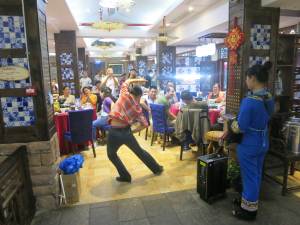 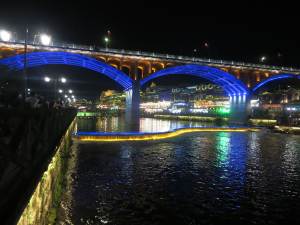 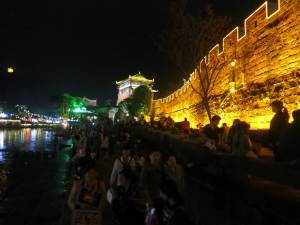 |
The Miao town that never sleeps? World cultural heritage, occasionally called the most beautiful town in China and a history of more than 300 years - that must bring the tourists in masses to Fenghuang. ZuZhou, 05.22 |
